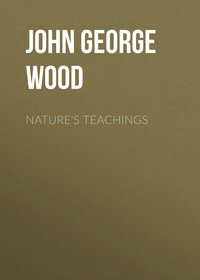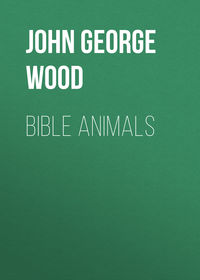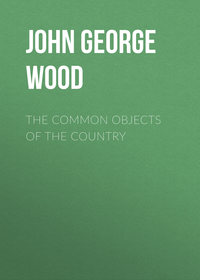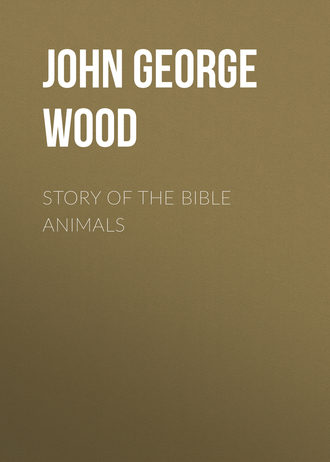 полная версия
полная версияStory of the Bible Animals
The ordinary food of the Ostrich consists of the seeds, buds, and tops of various plants. It seems strange, however, that in the deserts, where there is so little vegetation, the bird should be able to procure sufficient food to maintain its enormous body. Each of the specimens which are kept at the Zoological Gardens eats on an average a pint of barley, the same quantity of oats, four pounds' weight of cabbage, and half a gallon of chaff, beside the buns, bread, and other articles of food which are given to them by visitors.
Although the Ostrich, like many other inhabitants of the desert, can live for a long time without water, yet it is forced to drink, and like the camel, which it resembles in so many of its ways, drinks enormously, taking in the water by a succession of gulps. When the weather has been exceptionally hot, the Ostrich visits the water-springs daily, and is so occupied in quenching its thirst that it will allow the hunter to come within a very short distance. It appears, indeed, to be almost intoxicated with its draught, and, even when it does take the alarm, it only retreats step by step, instead of scudding off with its usually rapid strides.
The camel-like appearance of the Ostrich has already been mentioned. In the Arabic language the Ostrich is called by a name which signifies camel-bird, and many of the people have an idea that it was originally a cross between a bird and a camel.
The cry of the Ostrich is a deep bellow, which, according to travellers in Southern Africa, so resembles the roar of the lion that even the practised ears of the natives can scarcely distinguish the roar of the animal from the cry of the bird. The resemblance is increased by the fact that both the lion and Ostrich utter their cry by night. It is evidently to this cry that the prophet Micah alludes: "Therefore I will wail and howl, I will go stripped and naked: I will make a wailing like the dragons, and mourning as the owls" (Ostriches in marginal reading). The cry of the variety of Ostrich which inhabits Northern Africa is said to bear more resemblance to the lowing of an ox than the roar of the lion; but as the bird is smaller than its southern relative, the difference is probably accounted for.
It has been mentioned that the Ostrich has no weapons wherewith to fight for its young; still, though it be destitute of actual weapons, such as the spur of the gamecock or the beak and talons of the eagle, it is not entirely defenceless. Its long and powerful legs can be employed as weapons, and it can kick with such force that a man would go down before the blow, and probably, if struck on the leg or arm, have the limb broken. The blow is never delivered backward, as is the kick of the horse, but forward, like that of the kangaroo. The natives of the countries where it resides say that it is able to kill by its kick the jackal that comes to steal its eggs, and that even the hyæna and the leopard are repelled by the gigantic bird.

THE BITTERN
The Bittern and its general appearance—The bird of solitude—Difficulty of detecting the Bittern in its haunts—Mudie's description of the Bittern and its home—Nest of the Bittern—Scarcity of the bird at the present day—Food of the Bittern.
The Bittern belongs to the same family as the herons, the cranes, and the storks, and has many of the habits common to them all. It is, however, essentially a bird of solitude, hating the vicinity of man, and living in the most retired spots of marshy ground. As it sits among the reeds and rushes, though it is a large bird, it is scarcely visible even to a practised eye, its mottled plumage harmonizing with surrounding objects in such a way that the feathers of the bird can scarcely be distinguished from the sticks, stones, and grass tufts among which it sits. The ground colour of the plumage is dark buff, upon which are sprinkled mottlings and streaks of black, chestnut, grey, and brown. These mottled marks harmonize with the stones and tufts of withered grass, while the longitudinal dashes of buff and black on the neck and breast correspond with the sticks and reeds.
In a similar manner the tiger, though so large an animal, can lie in a very small covert of reeds without being detected, its striped fur corresponding with the reeds themselves and the shadows thrown by them; and the leopard can remain hidden among the boughs of a tree, its spotted coat harmonizing with the broken light and shade of the foliage.
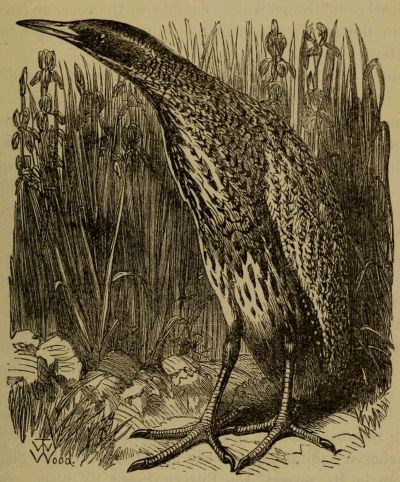
THE BITTERN.
The following powerful description of the Bittern's home is given by Mudie: "It is a bird of rude nature, where the land knows no character save that which the untrained, working of the elements impresses upon it; so that when any locality is in the course of being won to usefulness, the bittern is the first to depart, and when any one is abandoned, it is the last to return. 'The bittern shall dwell there' is the final curse, and implies that the place is to become uninhabited and uninhabitable. It hears not the whistle of the ploughman, nor the sound of the mattock; and the tinkle of the sheep-bell, or the lowing of the ox (although the latter bears so much resemblance to its own hollow and dismal voice, that it has given foundation to the name), is a signal for it to be gone.
"Extensive and dingy pools—if moderately upland, so much the better—which lie in the hollows, catching, like so many traps, the lighter and more fertile mould which the rains wash and the winds blow from the naked heights around, and converting it into harsh and dingy vegetation, and the pasture of those loathsome things which wriggle in the ooze, or crawl and swim in the putrid and mantling waters, are the habitation of the bittern.
"Places which scatter blight and mildew over every herb which is more delicate than a sedge, a carex, or a rush, and consume every wooded plant that is taller than the sapless and tasteless cranberry or the weeping upland willow; which shed murrain over the quadrupeds, chills which eat the flesh off their bones, and which, if man ventures there, consume him by putrid fever in the hot and dry season, and shake him to pieces with ague when the weather is cold and humid.
"Places from which the heath and the lichen stand aloof, and where even the raven, lover of disease, and battener upon all that expires miserably and exhausted, comes rarely and with more than wonted caution, lest that death which he comes to seal and riot upon in others should unawares come upon himself. The raven loves carrion on the dry and unpoisoning moor, scents it from afar, and hastens to it upon his best and boldest wing; but 'the reek o' the rotten fen' is loathsome to the sense of even the raven, and it is hunger's last pinch ere he come nigh to the chosen habitation, the only loved abode, of the bittern."
Secure in its retreat, the Bittern keeps its place even if a sportsman should pass by the spot on which it crouches. It will not be tempted to leave its retreat by noise, or even by stone throwing, for it knows instinctively that the quaking bogland which it selects as its home is unsafe for the step of man.
The very cry of the Bittern adds to this atmosphere of desolation. By day the bird is silent, but after the sun has gone down it utters its strange wild cry, a sound which exactly suits the localities in which it loves to make its habitation. During part of the year it only emits a sharp, harsh cry as it rises on the wing, but during the breeding season it utters the cry by which it summons its mate, one of the strangest love-calls that can be imagined. It is something between the neighing of a horse, the bellow of a bull, and a shriek of savage laughter. It is very loud and deep, so that it seems to shake the loose and marshy ground. There was formerly an idea that, when the Bittern uttered this booming cry, it thrust its bill into the soft ground, and so caused it to shake. In reality, the cry is uttered on the wing, the bird wheeling in a spiral flight, and modulating its voice in accordance with the curves which it describes in the air. This strange sound is only uttered by the male bird.

BITTERN. CORMORANT.
Like most of the long-legged wading birds, the Bittern is able to change its shape, and apparently to alter its size, in an astonishing manner. When it is walking over the ground, with head erect and eye glanced vigilantly at surrounding objects, it looks a large, bold, vigorous, and active bird. Next minute it will sink its head in its shoulders, so that the long beak seems to project from them, and the neck totally disappears, the feathers enveloping each other as perfectly and smoothly as if it never had had a neck. In this attitude it will stand for an hour at a time on one leg, with the other drawn close to its body, looking as dull, inert, and sluggish a bird as can well be imagined, and reduced apparently to one half of its former size. The Bittern is represented in one of its extraordinary attitudes on the plate which illustrates the cormorant.
The nest of the Bittern is placed on the ground, and near the water, though the bird always takes care to build it on an elevated spot which will not be flooded if the water should rise by reason of a severe rain. There is, however, but little reason for the Bittern to fear a flood, as at the time of year which is chosen for nest-building the floods are generally out, and the water higher than is likely to be the case for the rest of the year. The materials of the nest are found in marshes, and consist of leaves, reeds, and rushes.
As if to add to the general effect of its character, it is essentially a solitary bird, and in this characteristic entirely unlike its relatives the heron and the stork, which are peculiarly sociable, and love to gather themselves together in multitudes. But the Bittern is never found except alone, or at the most accompanied for a time by its mate and one or two young ones.
The localities in which it resides are sufficient evidence of the nature of its food. Frogs appear to be its favourite diet, but it also feeds on various fish, insects, molluscs, worms, and similar creatures. Dull and apathetic as it appears to be, it can display sufficient energy to capture tolerably large fish. Though the Bittern is only about two feet in total length, one of these birds was killed, in the stomach of which were found one perfect rudd eight inches in length and two in depth, together with the remains of another fish, of a full-grown frog, and of an aquatic insect. In another instance, a Bittern had contrived to swallow an eel as long as itself; while in many cases the remains of five or six full-grown frogs have been found in the interior of the bird, some just swallowed, and others in various stages of digestion.


THE HERON.
THE HERON
The Heron mentioned as an unclean bird—Nesting of the Heron—The papyrus marshes and their dangers—Description of the papyrus—Vessels of bulrushes.
The name of the Heron is only mentioned twice in the Scriptures—namely, in the two parallel passages of Lev. xi. 19 and Deut. xiv. 18; in both of which places the Heron is ranked among the unclean birds that might not be eaten.
In some of the cases where beasts or birds are prohibited as food, the prohibition seems scarcely needed. To us of the present day this seems to be the case with the Heron, as it is never brought to table. The reason for this disuse of the Heron as food is not that it is unfit for the table, but that it has become so scarce by the spread of cultivation and housebuilding, that it has been gradually abandoned as a practically unattainable article of diet. The flesh of the Heron, like that of the bittern, is remarkably excellent, and in the former days, when it was comparatively plentiful, and falconry was the ordinary amusement of the rich, the Heron formed a very important dish at every great banquet.

THE HERON.
The bird, however, must be eaten when young. A gentleman who liked to try experiments for himself in the matter of food, found that, if young Herons were properly cooked, they formed a most excellent dish, equal, in his opinion, to grouse. Wishing to have his own judgment confirmed by that of others, he had several of them trussed and dressed like wild geese, and served up at table under that name. The guests approved greatly of the bird, and compared it to hare, the resemblance being further increased by the dark colour of the flesh. There was not the slighest fishy flavour about the bird. This, however, is apt to be found in the older birds, but can be removed by burying them in the earth for several days, just as is done with the solan goose and one or two other sea-birds.
The abundance of birds belonging to the Heron tribe is well shown by some of the paintings and carvings on Egyptian monuments, in which various species of Herons and other water-birds are depicted as living among the papyrus reeds, exactly the locality in which they are most plentiful at the present day.
Unlike the bittern, the Heron is a most sociable bird, and loves not only to live, but even to feed, in company with others of its own species.
I have watched the Herons feeding in close proximity to each other. The birds were fond of wading stealthily along the edge of the lake until they came to a suitable spot, where they would stand immersed in the water up to the thighs, waiting patiently for their prey. They stood as still as if they were carved out of wood, the ripples of the lake reflected on their plumage as the breeze ruffled the surface of the water. Suddenly there would be a quick dive of the beak, either among the reeds or in the water, and each stroke signified that the Heron had caught its prey.
Frogs and small fishes are the usual food of the Heron, though it often grapples with larger prey, having been seen to capture an eel of considerable size in its beak. Under such circumstances it leaves the water, with the fish in its mouth, and beats it violently against a stone so as to kill it. Now and then the bird is vanquished in the struggle by the fish, several instances being known in which an eel, in its endeavours to escape, has twisted itself so tightly round the neck of the bird that both have been found lying dead on the shore.
In one such case the Heron's beak had struck through the eyes of the eel, so that the bird could not disengage itself. In another the Heron had tried to swallow an eel which was much too large for it, and had been nearly choked by its meal. The eel must necessarily have been a very large one, as the Heron has a wonderful capacity for devouring fish. Even when quite young, it can swallow a fish as large as a herring, and when it is full grown it will eat four or five large herrings at a meal.
Now when we remember that a man of average appetite finds one herring to form a very sufficient breakfast, we can easily imagine what must be the digestive power of a bird which, though very inferior to man in point of bulk, can eat four times as much at a meal. Even though the fish be much larger in diameter than the neck of the bird, the Heron can swallow it as easily as a small snake swallows a large frog. The neck merely seems to expand as if it were made of Indiarubber, the fish slips down, and the bird is ready for another.

THE HOME OF THE HERON.
Generally the Herons feed after sunset, but I have frequently seen them busily engaged in catching their prey in full daylight, when the sunbeams were playing in the water so as to produce the beautiful rippling effect on the Heron's plumage which has already been mentioned.
The Heron does not restrict itself to fishes or reptiles, but, like the bittern, feeds on almost any kind of aquatic animal which comes within its reach. When it lives near tidal rivers, it feeds largely on the shrimps, prawns, green crabs, and various other crustacea; and when it lives far inland, it still makes prey of the fresh-water shrimps, the water-beetles, and the boat-flies, and similar aquatic creatures. In fact, it acts much after the fashion of the lions, tigers, and leopards, which put up with locusts and beetles when they can find no larger prey.
The long beak of the Heron is not merely an instrument by which it can obtain food, but is also a weapon of considerable power. When attacked, it aims a blow at the eye of its opponent, and makes the stroke with such rapidity that the foe is generally blinded before perceiving the danger. When domesticated, it has been known to keep possession of the enclosure in which it lived, and soon to drive away dogs by the power of its beak. When it is young, it is quite helpless, its very long legs being unable to support its body, which is entirely bare of plumage, and has a very unprepossessing appearance.
The flight of the Heron is very powerful, its wings being very large in proportion to its slender body. Sometimes the bird takes to ascending in a spiral line, and then the flight is as beautiful as it is strong. When chased by the falcon it mostly ascends in this manner, each of the two birds trying to rise above the other.
The nest of the Heron is always made on the top of some lofty tree, whenever the bird builds in places where trees can be found; and as the bird is an eminently sociable one, a single nest is very seldom found, the Heron being as fond of society as the rook. In some parts of Palestine, however, where trees are very scarce, the Heron is obliged to choose some other locality for its nest, and in that case prefers the great thickets of papyrus reeds which are found in the marshes, and which are even more inaccessible than the tops of trees.
One of these marshes is well described by Mr. Tristram in his "Land of Israel." "The whole marsh is marked in the map as impassable; and most truly it is so. I never anywhere have met with a swamp so vast and utterly impenetrable.
"The papyrus extends right across to the east side. A false step off its roots will take the intruder over head in suffocating peat-mud. We spent a long time in attempting to effect an entrance, and at last gave it up, satisfied that the marsh birds were not to be had. In fact, the whole is simply a floating bog of several miles square; a very thin crust of vegetation covers an unknown depth of water; and, if the explorer breaks through this, suffocation is imminent. Some of the Arabs, who were tilling the plain for cotton, assured us that even a wild boar never got through it. We shot two bitterns, but in endeavouring to retrieve them I slipped from the root on which I was standing, and was drawn down in a moment, only saving myself from drowning by my gun, which had providentially caught across a papyrus stem."
It may here be mentioned that the bulrush of Scripture is undoubtedly the papyrus. The ark or basket of bulrushes, lined with slime and pitch, in which Moses was laid, was made of the papyrus, which at the present day is used for the manufacture of baskets, mats, sandals, and for the thatching of houses. Many tribes which inhabit the banks of the Nile make simple boats, or rather rafts, of the papyrus, which they cut and tie in bundles; and it is worthy of notice that the Australian native makes a reed boat in almost exactly the same manner.
Compare Is. xviii. 1, 2: "Woe to the land shadowing with wings, which is beyond the rivers of Ethiopia.
"That sendeth ambassadors by the sea, even in vessels of bulrushes." Did we not know that vessels are actually made of bulrushes at the present day, a custom which has survived from very ancient times, we might find a difficulty in understanding this passage, while the meaning is intelligible enough when it is viewed by the light of the knowledge that the Ethiopian of the present day takes gold, and ivory, and other merchandise down the Nile in his boat of papyrus (or bulrush) reeds tied together.

THE PAPYRUS PLANT.
The papyrus runs from ten to fifteen or sixteen feet in height, so that the Herons are at no loss for suitable spots whereon to place their nests. From the name "papyrus" our word paper is derived. The stems of the plant, after having been split into thin slices, joined together, and brought to a smooth surface, formed the paper upon which the ancient Egyptians wrote.
The Egrets, which are probably included under the generic title of Anâphah, are birds of passage, and at the proper season are plentiful in Palestine. These pretty birds much resemble the heron in general form, and in general habits both birds are very much alike, haunting the marshes and edges of lakes and streams, and feeding upon the frogs and other inhabitants of the water. In countries where rice is cultivated, the Egret may generally be seen in the artificial swamps in which that plant is sown. The colour of the Egret is pure white, with the exception of the train. This consists of a great number of long slender feathers of a delicate straw colour. Like those which form the train of the peacock, they fall over the feathers of the tail, and entirely conceal them.

THE CRANE
Various passages in which the Crane is mentioned—Its migratory habits, and loud voice—Geographical range of the Crane—Its favourite roosting-places—Size of the Crane, and measurement of the wings—The Crane once used as food—Plumes of the Crane and their use—Structure of the vocal organs—Nest and eggs of the Crane.
In the description of the dove and the swallow two passages have been quoted in which the name of the Crane is mentioned, one referring to its voice, and the other to its migratory instinct. The first passage occurs in Isa. xxxviii. 14: "Like a crane or swallow, so did I chatter;" and the other in Jer. viii. 7: "The turtle and the crane and the swallow observe the time of their coming."
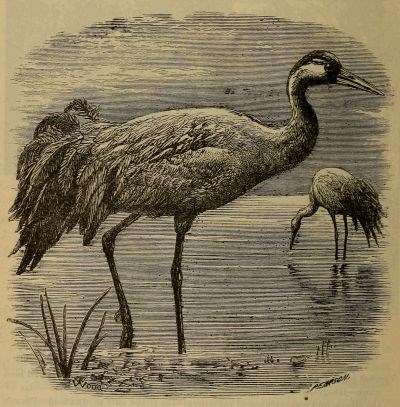
THE CRANE.
It is rather remarkable that in both these cases the word "Crane" is used in connexion with the swallow, or rather the swift, and that in both instances the names of the birds should have been interchanged. If we refer to the original of these passages, we shall find that the former of them would run thus, "Like a sis or an agur," and the latter thus, "The turtle and the sis and the agur." That in these passages the interpretation of the words sis and agur have been interchanged has already been mentioned, and, as the former has been described under the name of swallow or swift, we shall now treat of the latter under the title of Crane.
The species here mentioned is the common Crane, a bird which has a very wide range, and which seeks a warm climate on the approach of winter.
The Crane performs its annual migrations in company, vast flocks of many thousand individuals passing like great clouds at an immense height, whence their trumpet-like cry is audible for a great distance round, and attracts the ear if not the eye to them. Thus we have at a glance both the characteristics to which reference is made in the Scriptures, namely, the noisy cry and the habit of migration.
It is a very gregarious bird, associating with its comrades in flocks, just as do the starlings and rooks of our own country, and, like these birds, has favourite roosting-places in which it passes the night. When evening approaches, the Cranes may be seen in large flocks passing to their roosting-places, and, on account of their great size, having a very strange effect. A fair-sized Crane will measure seven feet across the expanded wings, so that even a solitary bird has a very imposing effect when flying, while that of a large flock of Cranes on the wing is simply magnificent.


